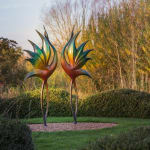Simon Gudgeon
Further images
-
(View a larger image of thumbnail 1
)

-
(View a larger image of thumbnail 2
)

-
(View a larger image of thumbnail 3
)

-
(View a larger image of thumbnail 4
)

-
(View a larger image of thumbnail 5
)

-
(View a larger image of thumbnail 6
)

-
(View a larger image of thumbnail 7
)

-
(View a larger image of thumbnail 8
)

-
(View a larger image of thumbnail 9
)

-
(View a larger image of thumbnail 10
)

-
(View a larger image of thumbnail 11
)

The Crane, otherwise known as the ‘bird of happiness’, inspired this sculpture. Inspiration also came from the shape of the Strelitzia, a South African flower, which is also known as the crane flower.
Cranes have appeared in art and mythology for millennia. In the Egyptian Museum in Cairo there is a beautiful limestone relief depicting these birds dating back to 2660 – 2590 BC. They are regularly depicted in tombs and temples including those in the ancient capital of Luxor.
In ancient Greece they drew inspiration from the flight form of the crane for several letters in their alphabet. They are also often depicted on vases and bowls dating back to the fifth century BC. They accompanied the gods Apollo and Hermes at stood at the side of Eros, the god of love. Cranes were also associated with Hephaestus, the god of sculptors.
However it is in China that the crane has been consistently adopted over the millennia as a symbol of good, to signify liberation from earthly constraints, as symbols of the unshakeable unity of two people, and everlasting happiness. A treatise dating back to the 6th century BC equates the crane with the philosophical concept of yang, which represents light and happiness. In Taoism it is the ‘immortal crane’ and Buddhism regards the crane as the godly bird, both regard the crane as the arbiter between ‘now’ and the ‘hereafter’ thus making it a symbol of immortality.
‘May your life be as long and happy as that of a crane’ is a common birthday toast in China, Japan, and Korea.
China’s First Emperor had thirteen large cranes in his artefact chamber dating from 22 BC, they were there to accompany him to the afterlife.
In the Confucian Book of Songs from the 3rd century BC it is written:-
‘When a crane, standing by a pond, cries out, its voice reaches heaven’
In Japanese Buddhism the ‘honourable Lord Crane’ (O tsuru sama) is a guarantor of longevity and happiness, he is a constant companion of Fukurokuju, one of the seven gods of fortune. The crane is also known as the ‘bird of happiness’ in Japan.










